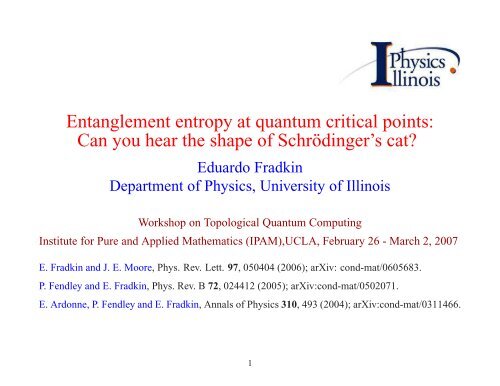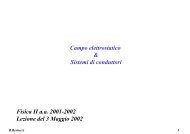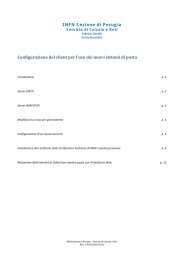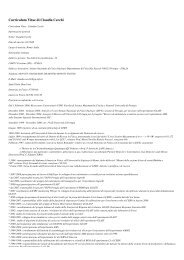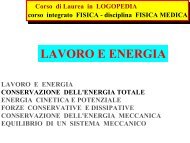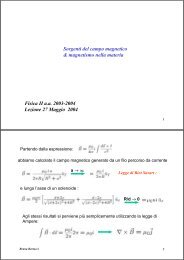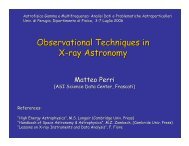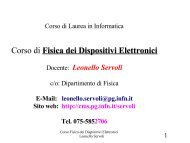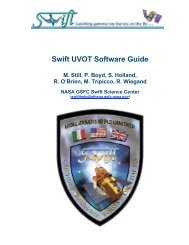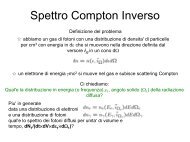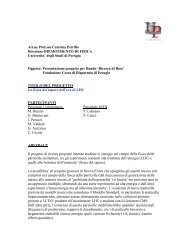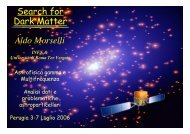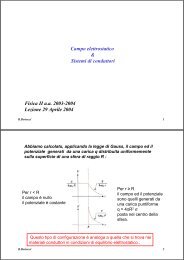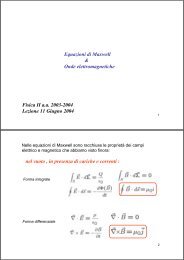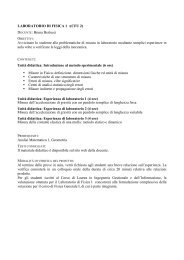Entanglement entropy at quantum critical points: Can you ... - INFN
Entanglement entropy at quantum critical points: Can you ... - INFN
Entanglement entropy at quantum critical points: Can you ... - INFN
You also want an ePaper? Increase the reach of your titles
YUMPU automatically turns print PDFs into web optimized ePapers that Google loves.
<strong>Entanglement</strong> <strong>entropy</strong> <strong>at</strong> <strong>quantum</strong> <strong>critical</strong> <strong>points</strong>:<br />
<strong>Can</strong> <strong>you</strong> hear the shape of Schrödinger’s c<strong>at</strong><br />
Eduardo Fradkin<br />
Department of Physics, University of Illinois<br />
Workshop on Topological Quantum Computing<br />
Institute for Pure and Applied M<strong>at</strong>hem<strong>at</strong>ics (IPAM),UCLA, February 26 - March 2, 2007<br />
E. Fradkin and J. E. Moore, Phys. Rev. Lett. 97, 050404 (2006); arXiv: cond-m<strong>at</strong>/0605683.<br />
P. Fendley and E. Fradkin, Phys. Rev. B 72, 024412 (2005); arXiv:cond-m<strong>at</strong>/0502071.<br />
E. Ardonne, P. Fendley and E. Fradkin, Annals of Physics 310, 493 (2004); arXiv:cond-m<strong>at</strong>/0311466.<br />
1
Outline<br />
• Motiv<strong>at</strong>ion<br />
• <strong>Entanglement</strong> <strong>entropy</strong><br />
• <strong>Entanglement</strong> <strong>entropy</strong> and <strong>quantum</strong> <strong>critical</strong>ity in 1 + 1 Dimensions<br />
• Topological Phases, Topological Field Theories and Quantum Phase<br />
Transitions<br />
• Conformal Quantum Critical Points in 2 + 1 dimensions<br />
• <strong>Entanglement</strong> Entropy of Scale Invariant Wave Functions<br />
2
Motiv<strong>at</strong>ion<br />
• <strong>Entanglement</strong> <strong>entropy</strong> is a clear measure of <strong>quantum</strong> mechanical<br />
correl<strong>at</strong>ions in many body systems and field theories.<br />
• It is however a very non-local quantity which very difficult to measure in<br />
macroscopic <strong>quantum</strong> systems.<br />
• Its behavior near <strong>quantum</strong> <strong>critical</strong> <strong>points</strong> is largely not understood except in<br />
one dimension.<br />
• Recent results show it is a quantity of interest in topological phases.<br />
3
<strong>Entanglement</strong> Entropy in Quantum Mechanics<br />
• Consider a <strong>quantum</strong> mechanical system with two sets of degrees of freedom, {ϕ A }<br />
and {ϕ B }. Given the pure st<strong>at</strong>e Ψ[ϕ A , ϕ B ] and the trivial density m<strong>at</strong>rix for the<br />
combined system A ∪ B,<br />
〈ϕ A , ϕ B |ρ A∪B |ϕ ′ A,ϕ ′ B〉 = Ψ[ϕ A , ϕ B ]Ψ ∗ [ϕ ′ A, ϕ ′ B]<br />
• The reduced density m<strong>at</strong>rix for A is constructed by tracing over the degrees of<br />
freedom in B:<br />
〈ϕ A |ρ A |ϕ ′ A〉 = tr B ρ A∪B<br />
• The von Neumann entanglement <strong>entropy</strong> is<br />
S A = −tr A (ρ A ln ρ A ) = −tr B (ρ B ln ρ B ) = S B<br />
• The von Neumann <strong>entropy</strong> gives a measurement of how entangled (or correl<strong>at</strong>ed) the<br />
degrees of freedom of A are with those of B.<br />
4
Quantum Phase Transitions and Quantum Criticality<br />
M<br />
order<br />
g c<br />
disorder<br />
g<br />
• Phase transitions <strong>at</strong> zero temper<strong>at</strong>ure tuned by a parameter g of a <strong>quantum</strong><br />
Hamiltonian<br />
• Scale Invariance <strong>at</strong> Quantum Critical Points: Correl<strong>at</strong>ion functions of local oper<strong>at</strong>ors<br />
exhibit scaling.<br />
• As the transition there is a diverging correl<strong>at</strong>ion length ξ ∼ |g − g c | −ν<br />
• The energy gap ∆ closes with a power law ∆ ∼ |g − g c | νz , where z is the dynamic<br />
<strong>critical</strong> exponent<br />
• For systems which exhibit an effective Lorentz invariance <strong>at</strong> <strong>critical</strong>ity z = 1; in<br />
general z ≠ 1.<br />
5
D = 1 Quantum Criticality: Conformal Invariance<br />
• Quantum <strong>critical</strong> systems with z = 1 in one dimension are special<br />
• In their 1 + 1-dimensional space-time they exhibit an infinite conformal invariance:<br />
Conformal Field Theory<br />
• The <strong>critical</strong> exponents are <strong>quantum</strong> numbers th<strong>at</strong> label the represent<strong>at</strong>ions of the<br />
(infinite-dimensional) group of conformal transform<strong>at</strong>ions<br />
• (Almost) Complete classific<strong>at</strong>ion of <strong>quantum</strong> phase transitions of unitary rel<strong>at</strong>ivistic<br />
(z = 1) systems in 1 + 1 dimensions in terms of Conformal Field Theory (CFT)<br />
• The central charge c (or conformal anomaly) and the coefficients of the oper<strong>at</strong>or<br />
product expansion (OPE) of the primary fields define the universal properties of the<br />
CFT.<br />
• Universal form of the low temper<strong>at</strong>ure specific he<strong>at</strong> C/L and of the ground st<strong>at</strong>e<br />
energy density E/L<br />
C<br />
L = π 6<br />
cT<br />
v ,<br />
E<br />
L = ε 0 + π 6<br />
cv<br />
L<br />
6
<strong>Entanglement</strong> and Conformal Invariance<br />
• Calcul<strong>at</strong>ions on a number of spin chains led to the suggestion th<strong>at</strong> the von Neumann<br />
<strong>entropy</strong> in D = 1 <strong>quantum</strong> <strong>critical</strong> systems has a universal term which scales as<br />
log L (Rico, L<strong>at</strong>orre, Vidal, and Kitaev)<br />
• Calbrese and Cardy (2004) (and Holzhey, Larson and Wilczek (1994)) used<br />
conformal invariance to show th<strong>at</strong>, for a large region of linear size L, embedded in<br />
an infinitely long 1 + 1-dimensional conformally invariant system, the von Neumann<br />
entanglement <strong>entropy</strong> has the asymptotic behavior<br />
S = π „ « L<br />
3 c log + finite terms<br />
a<br />
where s 0 is non-universal, a is a short-distance cutoff, and c is the central charge<br />
• Away from <strong>critical</strong>ity: there is a finite correl<strong>at</strong>ion length ξ.<br />
S = π „ « ξ<br />
3 c log + finite terms, for ξ ≫ a<br />
a<br />
• 1 + 1 dimensional disordered <strong>quantum</strong> systems <strong>at</strong> random fixed <strong>points</strong> also obey a<br />
logarithmic scaling law (even though they are scale but not conformal invariant!)<br />
(Refael and Moore, 2004).<br />
7
Issues on Scaling Behavior of Quantum <strong>Entanglement</strong><br />
• Behavior of <strong>quantum</strong> entanglement near <strong>quantum</strong> <strong>critical</strong> <strong>points</strong> in general and in<br />
higher dimensions.<br />
• Dependence on the dynamic <strong>quantum</strong> <strong>critical</strong> exponent z which determines the<br />
n<strong>at</strong>ure of <strong>quantum</strong> <strong>critical</strong>ity for local oper<strong>at</strong>ors.<br />
• Massive rel<strong>at</strong>ivistic (z = 1) (free) field theories obey an “area law” S = AL d−1<br />
(Srednicki, 1993) (where A is non-universal).<br />
• Calabrese and Cardy (2004) have used a heuristic scaling argument to argue th<strong>at</strong> the<br />
area law is generic to <strong>quantum</strong> <strong>critical</strong> <strong>points</strong> in all dimensions.<br />
• We will see however th<strong>at</strong>, for conformal <strong>quantum</strong> <strong>critical</strong> <strong>points</strong> in 2 + 1-dimensions<br />
(with z = 2) there is in fact a universal logarithmic term.<br />
• Universal finite terms appear in topological phases and depend on the <strong>quantum</strong><br />
dimensions.<br />
8
Spin Liquids and Topological St<strong>at</strong>es of M<strong>at</strong>ter<br />
• Liquid phases of electron fluids and spin systems without long range order,<br />
with or without time reversal symmetry breaking<br />
• Quasiparticles: vortices with fractional charge and fractional st<strong>at</strong>istics<br />
(Abelian and non-Abelian)<br />
• Hidden Topological Order and Topological Vacuum Degeneracy<br />
• Finite-dimensional quasiparticle Hilbert spaces ⇒ universal topological<br />
<strong>quantum</strong> computer<br />
9
“Known” Topological Quantum Liquids<br />
• 2DEG Fractional Quantum Hall Liquids<br />
– Abelian FQH st<strong>at</strong>es (Laughlin and Jain): fractional charge and Abelian<br />
fractional st<strong>at</strong>istics<br />
– Non-Abelian FQH st<strong>at</strong>es: Is ν = 5/2 a Pfaffian (Moore-Read) FQH<br />
st<strong>at</strong>e (firm candid<strong>at</strong>e) Is the pl<strong>at</strong>eau <strong>at</strong> ν = 12/5 a parafermion st<strong>at</strong>e<br />
(good possibility)<br />
• Rapidly rot<strong>at</strong>ing Bose gases: possible non-Abelian (Pfaffian) FQH st<strong>at</strong>e of<br />
bosons <strong>at</strong> ν = 1<br />
• Time-Reversal Breaking Superconductors: Sr 2 RuO 4 is a p x + ip y<br />
superconductor<br />
10
Challenges<br />
• To develop a consistent theory of topological phases (i.e. beyond FQH<br />
st<strong>at</strong>es) and to understand the underlying mechanisms<br />
• Wh<strong>at</strong> are the generic phases of models of topological liquids<br />
• Is the gap necessary <strong>Can</strong> a topological liquid be gapless<br />
• Concrete examples of l<strong>at</strong>tice models with local interactions with topological<br />
phases<br />
• Fractional St<strong>at</strong>istics: Abelian and non-Abelian<br />
• There has been some progress in constructing models with Abelian st<strong>at</strong>istics<br />
• To find experimentally realizable models (looks promising, not quite there<br />
yet)<br />
11
Time Reversal Invariant Spin Liquids: Quantum Dimer<br />
Models<br />
• Simple local models describing strongly frustr<strong>at</strong>ed and ring exchange<br />
<strong>quantum</strong> spin systems with a large spin gap and no long range spin order<br />
• They typically exhibit spin gap phases with different types of valence bond<br />
crystal orders<br />
• QDM have special solvable <strong>points</strong>, the Rokhsar-Kivelson (RK) point, where<br />
the exact ground st<strong>at</strong>e wave function has the short range RVB form<br />
|Ψ RVB 〉 = ∑ {C}<br />
|C〉,<br />
{C} = all dimer coverings of the l<strong>at</strong>tice<br />
• – Bipartite l<strong>at</strong>tices: the RK <strong>points</strong> are <strong>quantum</strong> (multi) <strong>critical</strong> <strong>points</strong>,<br />
described by an effective field theory with z = 2 and massless<br />
deconfined spinons, or first order transitions<br />
– Non-bipartite l<strong>at</strong>tices: QDMs have topological Z 2 deconfined phases<br />
with massive spinons and a topological 4-fold ground st<strong>at</strong>e degeneracy<br />
on a torus (Moessner and Sondhi, 1998)<br />
12
The Quantum Dimer Model<br />
H RK = ∑ i<br />
(vV i − tF i ), Rokhsar and Kivelson (1988)<br />
V i = ∣ ∣<br />
〉〈 ∣ ∣ + ∣ ∣<br />
〉〈 ∣ ∣ F i = ∣ ∣<br />
〉〈 ∣ ∣ + ∣ ∣<br />
〉〈 ∣ ∣<br />
Here each bar represents a spin singlet bond.<br />
For t = v ⇒ H RK = P i Q† i Q i , with Q i = ` 1 −1<br />
−1 1<br />
´.<br />
• The ground st<strong>at</strong>e wave function |Ψ 0 〉 has E = 0<br />
|Ψ 0 〉 = 1 √<br />
Zcl<br />
X<br />
where Z cl is the sum over all dimer configur<strong>at</strong>ions<br />
C<br />
|C〉 ,<br />
• Equal-time correl<strong>at</strong>ors in the <strong>quantum</strong> dimer model <strong>at</strong> the RK point are given by<br />
correl<strong>at</strong>ors of the classical dimer model.<br />
• This is actually a loop model: loops are the dimer moves from a reference st<strong>at</strong>e. This<br />
is the simplest loop model: the SU(2) 1 fully packed loop model.<br />
13
Dimers, heights and effective field theory<br />
Moessner, Sondhi and Fradkin; Ardonne, Fendley and Fradkin<br />
• The QDM can be mapped to a height model<br />
• Plaquette flip changes the height of th<strong>at</strong> plaquette by ±4, and the average height of<br />
the surrounding sites by ±1.<br />
• Equivalent configur<strong>at</strong>ions: h ∼ = h + 4.<br />
• Continuum limit: h ∼ = 4ϕ(x)<br />
Compactific<strong>at</strong>ion Radius: ϕ(x) ∼ = ϕ(x) + 1.<br />
• The Quantum Lifshitz model<br />
Hamiltonian:<br />
H =<br />
This is the Quantum Lifshitz Model.<br />
Z<br />
» 1<br />
d 2 x<br />
2 Π2 + κ2<br />
2<br />
–<br />
`∇2 ϕ´2<br />
(Henley; Moessner, Sondhi and Fradkin)<br />
• Action in imaginary time τ ⇔ smectic layers in 3D classical st<strong>at</strong>istical mechanics <strong>at</strong><br />
the Lifshitz transition.<br />
Z Z » –<br />
1<br />
S = d 2 x dτ<br />
2 (∂ τϕ) 2 + κ2 `∇2 ϕ´2<br />
2<br />
14
Scale Invariant Ground St<strong>at</strong>e Wave Functions and 2D<br />
Classical Critical Phenomena<br />
• Z »<br />
d 2 ⃗x − 1 “ δ<br />
” –<br />
2 κ 2<br />
+<br />
2 δϕ 2 (∇2 ϕ) 2 Ψ[ϕ] = EΨ[ϕ]<br />
Q(x) ≡ √ 1 „ « δ<br />
2 δϕ + κ∇2 ϕ Q † (x) ≡ √ 1 „<br />
− δ «<br />
2 δϕ + κ∇2 ϕ<br />
• Ground st<strong>at</strong>e wave-function, Ψ 0 [ϕ]<br />
Q(⃗x)Ψ 0 [ϕ] = 0 ⇒ Ψ 0 [ϕ] ∝ e −κ 2<br />
‖Ψ 0 ‖ 2 =<br />
Z<br />
Dϕ e −κ Z<br />
Z<br />
d 2 x (∇ϕ(x)) 2<br />
• The ground st<strong>at</strong>e wave function is conformally invariant<br />
d 2 x (∇ϕ(x)) 2<br />
15
Mapping to a 2D c = 1 Euclidean CFT<br />
• The probability for a configur<strong>at</strong>ion |ϕ〉 is the Gibbs weight of a 2D classical<br />
Gaussian model, a Euclidean 2D free massless scalar field.<br />
• At these <strong>quantum</strong> <strong>critical</strong> <strong>points</strong> the ground st<strong>at</strong>e wave function is scale invariant<br />
• The equal-time expect<strong>at</strong>ion values of the observables are correl<strong>at</strong>ors in this c = 1<br />
conformal field theory.<br />
• The equal-time expect<strong>at</strong>ion value for oper<strong>at</strong>ors in the <strong>quantum</strong> Lifshitz model are<br />
given by correl<strong>at</strong>ors of the massless free boson conformal field theory with central<br />
charge c = 1. Time-dependent correl<strong>at</strong>ors exhibit power-law behavior with<br />
dynamical exponent z = 2.<br />
• M<strong>at</strong>ching the correl<strong>at</strong>ion functions of the RK and Lifshitz models, one finds<br />
κ = 1/2π.<br />
• This is a multi<strong>critical</strong> point with many relevant perturb<strong>at</strong>ions: e.g diagonal dimers<br />
drive the system into a Z 2 topological phase<br />
16
Phase diagram for a <strong>quantum</strong> eight vertex model<br />
Ardonne, Fendley and Fradkin<br />
d 2<br />
2<br />
6-vertex<br />
Confining<br />
Ordered<br />
Broken Z 2<br />
III<br />
KT<br />
Kitaev<br />
6-vertex<br />
dual 6-vertex<br />
I<br />
KT<br />
2<br />
Deconfining<br />
Quantum Disordered<br />
Z 2 Topological Phase<br />
II<br />
dual 6-vertex<br />
Confining<br />
Ordered<br />
Broken Z 2<br />
c 2<br />
17
Str<strong>at</strong>egy for a Generaliz<strong>at</strong>ion<br />
with Paul Fendley<br />
• Each basis st<strong>at</strong>e in the Hilbert space is a loop configur<strong>at</strong>ion in 2D<br />
• Start with the st<strong>at</strong>istics we wish to have, and work backward<br />
• Algebraic characteriz<strong>at</strong>ion of braiding for SU(2) k and SO(3) k Chern-Simons<br />
• Braid m<strong>at</strong>rix of a 2+1-dimensional theory as a limit of the S-m<strong>at</strong>rix of an associ<strong>at</strong>ed<br />
rel<strong>at</strong>ivistic 1+1 dimensional model<br />
• We construct <strong>quantum</strong> 2D models with these braid rel<strong>at</strong>ions by utilizing the structure<br />
of the factorizable S-m<strong>at</strong>rices of integrable 1D models.<br />
• We embed the 1D model in 2D Euclidean space, and find an RK Hamiltonian<br />
• Loop gases:<br />
– SU(2) k case: O(n) loop l<strong>at</strong>tice model with n = 2cos(π/(k + 2))<br />
(self-avoiding and mutually-avoiding loops)<br />
– SO(3) k case: domain walls of a Q-st<strong>at</strong>e Potts model with<br />
Q = 4cos 2 (π/(k + 2)) (loops intersect and branch: nets)<br />
SO(3) 3 : Chrom<strong>at</strong>ic Polynomial “Loop” gas wave function and Fibonacci<br />
anyons.<br />
18
<strong>Entanglement</strong> Entropy of 2D Quantum Critical St<strong>at</strong>es<br />
with Joel Moore<br />
• Kitaev and Preskill (2006), and Levin and Wen (2006) showed th<strong>at</strong> the entanglement<br />
(von Neumann) <strong>entropy</strong> S of a region of linear size L in 2D topological phases has<br />
the behavior<br />
S = αL − γ + O(1/L)<br />
α is a non-universal coefficient and γ = ln D is a finite universal constant,<br />
D = p Pi d2 i , determined by the <strong>quantum</strong> dimensions d i of the excit<strong>at</strong>ions of the<br />
topological phase.<br />
• This topological <strong>entropy</strong> plays a crucial role in single point contacts in non-Abelian<br />
FQH st<strong>at</strong>es (Fendley, Fisher and Nayak, 2006) and gives new meaning to the<br />
boundary <strong>entropy</strong> of <strong>quantum</strong> impurity problems and 1D boundary CFTs (Affleck<br />
and Ludwig)<br />
• The proximity of the 2D conformal <strong>quantum</strong> <strong>critical</strong> <strong>points</strong> we discussed here to 2D<br />
topological phases suggest th<strong>at</strong> they may hold clues on this behavior.<br />
• Is there a universal sign<strong>at</strong>ure in the von Neumann <strong>entropy</strong> of <strong>quantum</strong> <strong>critical</strong><br />
systems<br />
19
<strong>Can</strong> <strong>you</strong> hear the shape of Schrödinger’s C<strong>at</strong><br />
• For conformal <strong>quantum</strong> <strong>critical</strong> <strong>points</strong>, the Hilbert space has an orthonormal basis of<br />
st<strong>at</strong>es |{φ}〉 indexed by classical configur<strong>at</strong>ions {φ}, and the ground st<strong>at</strong>e |Ψ 0 〉 of<br />
the bipartite system is determined by a CFT action S:<br />
|Ψ 0 〉 = 1 √<br />
Zc<br />
∫<br />
(dφ) e −S({φ})/2 |{φ}〉.<br />
Z c = R (dφ)e −S({φ}) , and expect<strong>at</strong>ion values are CFT correl<strong>at</strong>ors.<br />
• <strong>Entanglement</strong> Entropy<br />
S = −Trρ A log ρ A = − ∂Trρn A<br />
∂n<br />
∣<br />
n=1<br />
.<br />
20
•<br />
〈{φ A 1 }|ρ A |{φ A 2 }〉 = Tr φ B (〈{φ A 1 }| ⊗ 〈{φ B }|ψ 0 〉〈ψ 0 (|{φ A 2 }〉 ⊗ |{φ B }〉<br />
= 1 Z c<br />
∫<br />
(dφ B )e −(SA (φ A 1 )/2+SA (φ A 2 )/2+S∂ (φ A 1 ,φB )/2+S ∂ (φ A 2 ,φB )/2+S B (φ B )) .<br />
Here the action has been divided into regions A, B, and the boundary ∂, where the<br />
last takes into account contributions mixing the A and B degrees of freedom<br />
• Higher powers of the density m<strong>at</strong>rix need not trace to unity: Tr ρ n A is now a sum<br />
over n configur<strong>at</strong>ions defined in A and n configur<strong>at</strong>ions defined in B. The key is to<br />
keep track of how these different configur<strong>at</strong>ions are stitched together <strong>at</strong> the boundary<br />
by the terms S ∂ th<strong>at</strong> link A and B: {φ A i } is linked to {φ B i } as well as {φ B i+1} for<br />
i = 1,...,n − 1, and {φ A n } is linked to {φ B n } and {φ B 1 }. This is normalized<br />
through division by (Z c ) n , which can be thought of again as n copies of A and B<br />
configur<strong>at</strong>ions, but with {φ A i } linked only to {φ B i }.<br />
21
φ 2,A = φ ′ 1,A<br />
φ 2,B = φ ′ 2,B<br />
φ 1,A = φ ′ 2,A<br />
φ 1,B = φ ′ 1,B<br />
Ω A<br />
Γ<br />
Ω B<br />
22
• The boundary terms impose continuity of the fields in the CFT because strong local<br />
fluctu<strong>at</strong>ions are penalized in the action. A key fe<strong>at</strong>ure of the replicas in the<br />
numer<strong>at</strong>or is th<strong>at</strong> each replica on A is connected symmetrically to two different<br />
replicas on B and vice versa. The symmetry, which for N replicas is the Schoenflies<br />
group C Nv (the cyclic group plus vertical mirror plane), prevents a unique<br />
idenfitic<strong>at</strong>ion of replicas on A with replicas on B except for N = 1, so the<br />
numer<strong>at</strong>or cannot be equivalent to the denomin<strong>at</strong>or (N free fields on A ∪ B). Instead<br />
the fields from different replicas are forced to agree on the boundary: schem<strong>at</strong>ically<br />
Tr ρ n A =<br />
Z(n configur<strong>at</strong>ions agreeing on the boundary)<br />
Z(n independent configur<strong>at</strong>ions)<br />
= Trρ n B<br />
• Trρ n A can be put in a form th<strong>at</strong> simplifies taking the deriv<strong>at</strong>ive as n → 1: for an<br />
explicit realiz<strong>at</strong>ion, consider the case of a free scalar field. Then the condition th<strong>at</strong> n<br />
scalar fields φ i agree with each other on the boundary can be s<strong>at</strong>isfied by forming<br />
n − 1 linear combin<strong>at</strong>ions 1 √<br />
2<br />
(φ i − φ i+1 ), which vanish <strong>at</strong> the boundary i.e., s<strong>at</strong>isfy<br />
Dirichlet boundary conditions, plus one linear combin<strong>at</strong>ion 1 √ n<br />
Pi=1,...,n φ i th<strong>at</strong><br />
has no boundary condition (i.e., is a free field on A ∪ B).<br />
23
• For any CFT there exists a conformal boundary condition th<strong>at</strong> generalizes the notion<br />
of the Dirichlet boundary condition in the free case. In terms of the partition<br />
functions Z D , for a field in the whole system A ∪ B th<strong>at</strong> vanishes <strong>at</strong> the boundary,<br />
and Z F , for a field th<strong>at</strong> is free <strong>at</strong> the boundary,<br />
Tr ρ n A = Zn−1 D<br />
Z F<br />
n =<br />
Z F<br />
(<br />
ZD<br />
Z F<br />
) n−1<br />
S = − log Z D<br />
Z F<br />
= − log ZA D ZB D<br />
Z F<br />
.<br />
• In the last equality, the Dirichlet boundary condition <strong>at</strong> the boundary was used to<br />
split the partition function into contributions from A and B, each including the<br />
boundary with Dirichlet boundary conditions.<br />
• The entanglement <strong>entropy</strong> for a general conformal <strong>quantum</strong> <strong>critical</strong> point is just the<br />
dimensionless free energy difference induced by the partition in the associ<strong>at</strong>ed CFT:<br />
S = F A + F B − F A∪B .<br />
24
• For the QCPs we are discussing here Z is the partition function of a CFT with<br />
Dirichlet BCs. For a bounded region of linear size L and smooth boundary, it obeys<br />
the ‘Mark Kac law’ (‘<strong>Can</strong> <strong>you</strong> hear the shape of a drum’)<br />
F = aL 2 + bL − c χ log L + O(1)<br />
6<br />
(Cardy and Peschel)<br />
where a and b are non-universal, and χ is the Euler characteristic of the region<br />
(manifold):<br />
χ = 2 − 2h − b,<br />
h = # handles, b = # boundaries<br />
• This result suggests the existence of a log L dependence with an universal coefficient<br />
associ<strong>at</strong>ed with the central charge c of the associ<strong>at</strong>ed CFT<br />
• This result implies th<strong>at</strong> for a QCP described by a scale (and conformally) invariant<br />
ground st<strong>at</strong>e wave function, the entanglement <strong>entropy</strong> of regions A and B with a<br />
smooth common boundary has a universal logarithmic term of the form<br />
∆S = − c 6 (χ A + χ B − χ A∪B ) log L<br />
25
For regions A ⊆ B the coefficient of the<br />
log L is zero since in this case<br />
χ A + χ B = χ A∪B ⇒ ∆S = 0<br />
B<br />
A<br />
If the regions A and B are physically<br />
separ<strong>at</strong>e and have no common intersection,<br />
χ A + χ B − χ A∪B ≠ 0. In this<br />
case, which corresponds to a process<br />
in which the system physically splits in<br />
two disjoint parts, there is a universal<br />
log L term in the entanglement <strong>entropy</strong><br />
<strong>at</strong> <strong>quantum</strong> <strong>critical</strong>ity, proportional to the<br />
central charge c of the associ<strong>at</strong>ed CFT!<br />
A ∪ B<br />
A<br />
B<br />
26
If the A and B share a common boundary,<br />
there is a log L term whose coefficient<br />
is determined by the angles <strong>at</strong> the<br />
intersections<br />
B<br />
A<br />
Or if the boundary of A is not smooth,<br />
in which case the coefficient depends on<br />
the angles α i for both regions<br />
(∆S) i = c α i<br />
24π<br />
(<br />
1 −<br />
( π<br />
α i<br />
) 2<br />
)<br />
log L<br />
B<br />
α 2<br />
α 1<br />
A α 3<br />
α 4<br />
Finite terms in the entanglement <strong>entropy</strong> depend on scale-invariant aspect r<strong>at</strong>ios<br />
27
Away from Quantum Criticality: Topological Phases<br />
• Topological Phases are proxim<strong>at</strong>e to conformal <strong>quantum</strong> <strong>critical</strong> <strong>points</strong> and<br />
can be accessed by relevant perturb<strong>at</strong>ions<br />
• Topological Phases have a finite correl<strong>at</strong>ion length ξ.<br />
S = c′<br />
3 log ξ a + . . . for ξ ≫ a<br />
• For a < ξ < ∞, the <strong>entropy</strong> is defined by a crossover scaling function<br />
whose behavior is controlled by the correl<strong>at</strong>ion length ξ<br />
• At the stable fixed point, ξ → a<br />
S = s 0<br />
L<br />
a − γ<br />
γ is universal (Kitaev and Preskill (2006); Levin and Wen (2006).)<br />
28
Conclusions<br />
• We examined the behavior of the Von Neumann entanglement <strong>entropy</strong> for a class of<br />
<strong>quantum</strong> <strong>critical</strong> <strong>points</strong> in 2 + 1 dimensions with conformally invariant wave<br />
functions<br />
• These <strong>quantum</strong> <strong>critical</strong> <strong>points</strong> are proxim<strong>at</strong>e to topological phases and can be used to<br />
access them<br />
• The entanglement <strong>entropy</strong> <strong>at</strong> these conformal <strong>quantum</strong> <strong>critical</strong> <strong>points</strong> also has<br />
universal logarithmic terms which become manifest in topology changing processes<br />
• This result suggests th<strong>at</strong> the entanglement <strong>entropy</strong> is sensitive to global properties<br />
not only in topological phases but also <strong>at</strong> <strong>quantum</strong> <strong>critical</strong>ity.<br />
29


